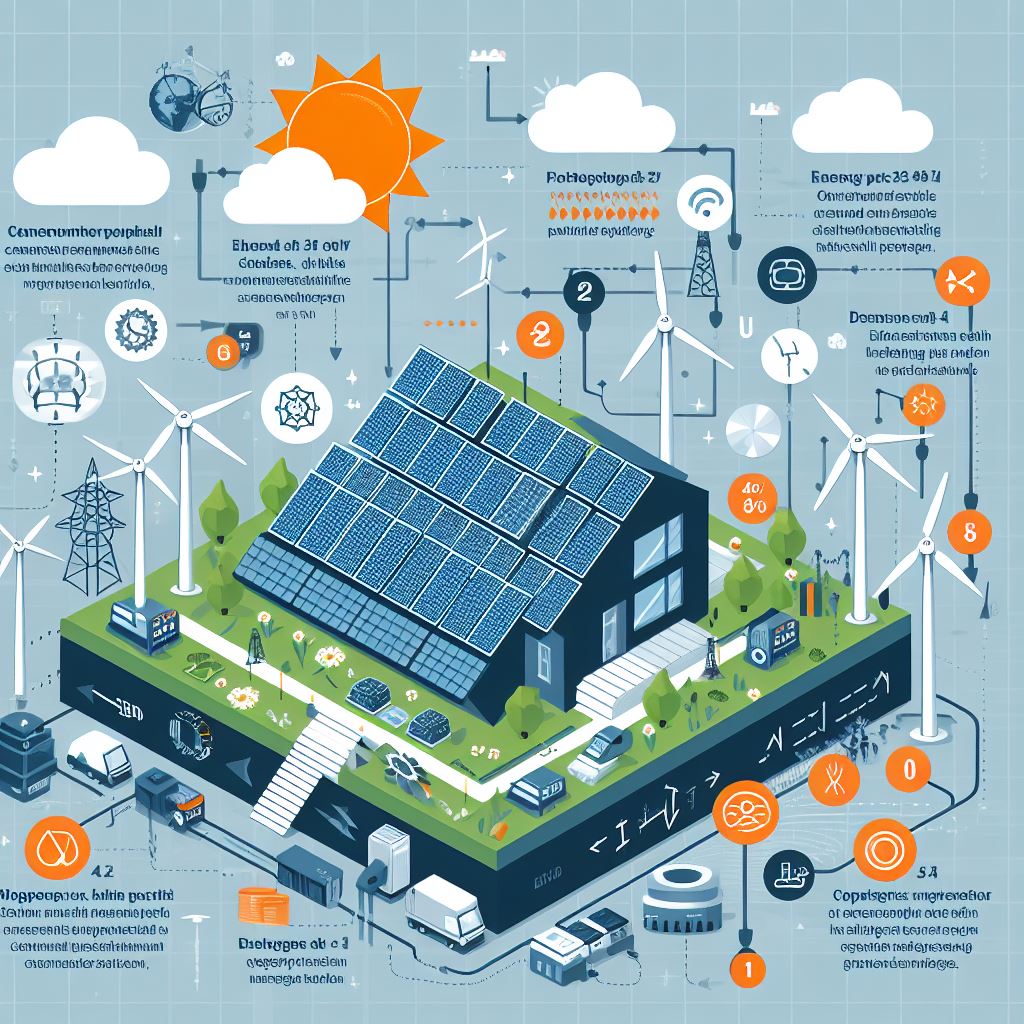Hybrid Solar System Design Calculation involve determining energy needs and panel efficiency. This ensures the system meets demand with optimal power generation.
Hybrid solar systems are a popular solution for those seeking energy independence while maintaining grid connectivity. These systems combine solar panels, batteries, and a connection to the grid, offering a balance of self-sufficiency and reliability. Calculating the specifications for a hybrid solar system requires assessing your daily energy consumption and peak electricity demands.

Matching this data with the local solar irradiance values ensures you choose the right size and number of solar panels. Additionally, battery storage capacity is critical to maintain power supply during periods of low sunlight or high demand. Considering factors such as roof orientation, shading, and panel efficiency is paramount to maximizing energy production. This introduction sets the stage for a deeper dive into the intricacies of designing a tailored hybrid solar system that aligns with a user’s specific energy profile and geographic considerations.
Hybrid Solar System Design Fundamentals
The leap into renewable energy through solar technology has become more attainable and efficient with the advent of hybrid solar systems. Understanding the design calculation fundamentals of these intricate systems allows for optimal use of solar energy while ensuring reliability and cost-effectiveness. This segment delves into the intricacies of hybrid solar system design, from comprehending their functionality, identifying key components and their roles, to contrasting the benefits they offer compared to traditional setups.
Understanding Hybrid Solar Systems
Hybrid solar systems exemplify the cutting-edge convergence of solar power with alternative energy sources. Unlike standalone solar or grid-tied systems, they harness the sun’s power while remaining connected to the grid and often include a battery storage component. They are designed to maximize energy independence while providing a safety net through grid connectivity. The design calculations focus on balancing the energy produced, the load requirements, and the battery storage capacity to ensure seamless energy supply during varying conditions.
Key Components And Their Role
Solar Panels: Convert sunlight to electricity.
Inverter: Converts DC electricity from panels to AC for home use.
Batteries: Store excess electricity for later use.
Charge controller: Regulates the charging rate for batteries to prevent overcharging.
Grid connection: Allows surplus energy to be sent back to the grid or additional energy to be drawn when needed.
Management System: Monitors and manages the distribution and flow of electricity.
Advantages Of Hybrid Systems Over Traditional Setups
Enhanced Energy Security: Provides consistent power supply by balancing between solar, battery, and grid.
Cost Savings: Reduces electricity bills by optimizing self-consumption and offering the possibility of selling surplus back to the grid.
Increased Self-Sufficiency: Decreases reliance on the grid with stored solar energy, especially during peak demand or outages.
Flexible Design: Can be tailored to different energy needs and scales, adaptable to future alterations or expansions.
Eco-Friendly: Lowers carbon footprint by utilizing renewable sources and decreasing reliance on fossil fuels.

Assessing Your Hybrid Solar Needs
Embarking on the journey to green energy with a hybrid solar system requires precise calculations to ensure the setup meets your specific energy needs effectively. From analyzing energy consumption patterns to estimating solar generation potential and factoring in the battery storage, a well-calculated approach can guarantee that your solar system is not only efficient but also cost-effective in the long run. Let’s delve into the factors that contribute to tailoring the perfect hybrid solar system for your home or business.
Analyzing Energy Consumption Patterns
Understanding your energy consumption patterns stands as the cornerstone of designing a hybrid solar system. A thorough analysis involves:
Collecting electricity bills to gauge monthly energy usage.
Identifying peak load times to understand when energy demand surges.
Assessing the consistency of energy usage throughout different seasons.
This data enables a more tailored system that aligns with your energy utilization, ensuring you have sufficient power during high-demand periods and reducing wastage during low usage times.
Estimating Solar Power Generation Potential
To harness the sun’s energy most effectively, one must accurately estimate the solar power generation potential. Factors involved in this estimation include:
Local climate data to understand sun exposure throughout the year.
The angle and orientation of the solar panel installation for maximum efficiency.
An analysis of any shading that might occur, impeding panel performance.
Tools such as solar insolation maps and PVWatts can aid in determining this potential, offering a glimpse into the energy your system will generate, which is critical for achieving energy independence.
Considering Battery Storage Requirements
For continuous power and energy security, assessing battery storage requirements is essential. Elements to factor in your calculations include:
Energy Reserve
How much energy needs to be stored for nights and cloudy days.
Usage Patterns
Alignment of storage capacity with peak and off-peak usage times.
Battery Type
Choice of battery technology balancing cost, lifespan, and efficiency.
Ensuring the right balance between generation and storage is key to a self-sufficient and resilient hybrid solar system, safeguarding against power outages and the unpredictability of weather.

Credit: Youtube
How To Calculate Hybrid Solar System Size
Designing a hybrid solar system requires precise calculations to ensure efficiency and reliability. To calculate the correct size for your hybrid solar system, it’s essential to consider various factors like sunlight availability, panel efficiency, energy consumption, and peak demand. A well-calculated system size will maximize your energy savings while ensuring you have a dependable source of power.
Evaluating Sunlight Availability And Panel Efficiency
The first step in calculating the size of your hybrid solar system is to evaluate the availability of sunlight in your location. This involves analyzing the average number of peak sun hours per day across different seasons. Solar panel efficiency is another crucial factor, as it determines how much of the sunlight can be converted into electricity. Choose solar panels with the highest efficiency to optimize usage of the available sunlight.
Calculating Required Number Of Solar Panels
Once you understand your area’s sunlight availability and have chosen your solar panels, you’ll need to calculate the energy usage your system needs to cover. To calculate the required number of solar panels, divide your daily energy usage (in watt-hours) by the peak sun hours and then divide by the panel’s wattage.
Understand your daily energy consumption in watt-hours.
Divide the daily energy consumption by peak sun hours.
Divide the result by the panel’s wattage. This gives you the number of panels needed.
Sizing The Inverter For Peak Demand
The inverter is a key component of your hybrid solar system that converts the DC electricity generated by the solar panels into AC electricity for home use. Sizing the inverter requires understanding your peak load or the maximum power drawn at any one time. This ensures the inverter can handle the highest load without being overloaded.
Add additional rows as needed

Add up the wattage of all appliances to find the peak load and select an inverter that can handle this demand. Consider choosing an inverter with a 25% higher capacity than your peak load to accommodate for potential expansion and ensure seamless operation.
Implementing Hybrid Solar Calculations
Calculating the design for a hybrid solar system goes beyond simply picking out panels and batteries. A precise hybrid solar system calculation considers the solar irradiance available in the area, potential system losses, and the best orientation and tilt of the solar panels to optimize energy production. Here, we dive into the specifics of how to implement these calculations to design an efficient and effective hybrid solar power system.
Using Solar Irradiance Data Effectively
Solar irradiance is the power per unit area received from the sun in the form of electromagnetic radiation. Accurate data is crucial for the design of a hybrid solar system, as it directly influences the expected solar energy yield. To make the most of this data:
Collect local solar irradiance data from authoritative sources, such as meteorological offices or specialized solar data providers.
Use historical weather patterns to forecast probable solar energy availability throughout the year.
Apply this data to estimate the solar panel’s output, taking into account the specific geographic location of the installation.
Factoring In System Losses, Orientation, And Tilt
A successful hybrid solar system design must consider not just the theoretical output of solar panels, but also the realistic conditions that will affect their performance:
System losses: Account for inefficiencies due to wiring, inverters, temperature, and shading.
Orientation and tilt: Align solar panels for maximum exposure to sunlight. Optimal angles vary by location and should match the average angle of the sun over the year.
Calculate the impact of these factors to make adjustments to the overall system size to meet the intended energy production goals.
Tools And Software For Precise Calculations
To ensure precision in these calculations, professional tools and software come into play:

These tools can simulate various conditions and provide a detailed understanding of system performance. Leverage them to:
Carry out what-if scenarios to understand the implications of different design choices.
Optimize system design based on empirical data rather than assumptions.
Generate reports and forecasts that can help in decision-making or securing financing for the project.
Optimizing Hybrid Solar System Performance
An efficient hybrid solar system not only allows for significant energy savings but also enhances overall system longevity. By carefully calculating and designing the balance between solar and grid energy, along with optimizing battery usage, a hybrid solar system’s performance is propelled to its peak competency. In this pursuit, specific practices and calculations must be adhered to.
Balancing Solar And Grid Energy Utilization
The cornerstone of a hybrid solar system’s efficiency lies in its ability to dynamically balance between harnessing solar power and drawing energy from the grid. This ensures maximum use of clean energy while maintaining a reliable power supply. A robust energy management system that tracks real-time usage and solar generation, coupled with predictive analytics for weather and usage patterns, can optimize this balance and lead to significant savings.
Calculate solar energy generation potential based on location and panel capacity.
Analyze energy consumption patterns to align with peak solar production times.
Integrate smart switches to automatically shift between solar and grid power.
Enhancing Battery Lifespan And Efficiency
To optimize a hybrid solar system, ensuring the longevity and efficiency of the battery storage is paramount. A key consideration is to operate the battery within its ideal capacity, neither overcharging nor depleting it entirely. Implementing a smart battery management system can closely monitor and maintain optimal charge levels, improving both performance and lifespan.

Adhering to these ranges reduces the stress on the battery cells and extends their serviceable life significantly.
Regular Maintenance And Monitoring Practices
Continuous monitoring and routine maintenance are indispensable for sustaining optimal performance of a hybrid solar system. Regular checks can uncover potential issues before they escalate, thus preserving the system’s integrity. A hybrid solar system benefits from:
Periodic inspection of solar panels for cleanliness and obstructions.
Scheduled testing of all electrical connections to prevent power loss.
Software updates for the energy management system to refine performance algorithms.
Professional assessment to calibrate and fine-tune system components.
Implementing these practices helps in predicting system faults and improving the system’s reliability and productivity.

Credit: Youtube
FAQs For How Does Hybrid Solar System Design Calculation
What Is A Hybrid Solar System?
A hybrid solar system combines grid electricity with solar power, utilizing batteries for energy storage. This ensures power availability both day and night, enhancing energy independence and efficiency.
How Do You Calculate Hybrid Solar System Size?
Calculating system size involves assessing energy consumption, sunlight hours, and backup requirements. It balances solar production potential and storage capacity to meet specific energy needs.
What Are The Components Of A Hybrid Solar System?
Key components include solar panels, inverters, batteries, and a management system. These work together to harvest, convert, and store energy, while maintaining grid connection.
Can Hybrid Solar Systems Go Off-grid?
Hybrid solar systems can operate off-grid with sufficient battery storage, although they’re generally connected to the grid for backup and excess energy sales.
Conclusion
Navigating the complexities of hybrid solar system design calculation requires precision and expertise. By grasping the key factors and employing the right tools, homeowners and businesses can harness maximum efficiency and cost savings from their systems. Remember, success lies in the details, so thorough planning and professional guidance are essential.
Let’s empower our future with sustainable energy, meticulously engineered.

